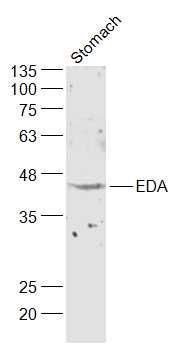产品货号 : mlR12347
英文名称 : EDA
中文名称 : 外胚层发育不良蛋白1抗体
别 名 : Ectodysplasin A, membrane form; Ectodermal dysplasia 1, anhidrotic; Ectodermal dysplasia protein; Ectodermal dysplasia, anhidrotic (hypohydrotic); Ectodysplasin A; ECTODYSPLASIN A1 ISOFORM; ECTODYSPLASIN A2 ISOFORM; ECTODYSPLASIN; Ectodysplasin-A; ED1 A1; ED1 A2; ED1; ED1 GENE; Eda A1; Eda A2; eda; EDA protein; EDA protein homolog; EDA_HUMAN; EDA1; EDA1 GENE; EDA2; HED; ODT1; Oligodontia 1; STHAGX1; Ta; Tabby; Tabby protein; X linked anhidroitic ectodermal dysplasia protein; XHED; XLHED.
研究领域 : 细胞生物 发育生物学 信号转导 干细胞 细胞膜蛋白
抗体来源 : Rabbit
克隆类型 : Polyclonal
交叉反应 : Human, Mouse, Rat, Cow,
产品应用 : WB=1:500-2000 ELISA=1:500-1000 IHC-F=1:400-800 ICC=1:100-500 IF=1:100-500 (石蜡切片需做抗原修复)
not yet tested in other applications.
optimal dilutions/concentrations should be determined by the end user.
分 子 量 : 41kDa
细胞定位 : 细胞膜
性 状 : Lyophilized or Liquid
浓 度 : 1mg/ml
免 疫 原 : KLH conjugated synthetic peptide derived from human Ectodysplasin-A, membrane form:101-200/391 <Extracellular>
亚 型 : IgG
纯化方法 : affinity purified by Protein A
储 存 液 : 0.01M TBS(pH7.4) with 1% BSA, 0.03% Proclin300 and 50% Glycerol.
保存条件 : Store at -20 °C for one year. Avoid repeated freeze/thaw cycles. The lyophilized antibody is stable at room temperature for at least one month and for greater than a year when kept at -20°C. When reconstituted in sterile pH 7.4 0.01M PBS or diluent of antibody the antibody is stable for at least two weeks at 2-4 °C.
PubMed : PubMed
产品介绍 : Affected males of X-linked anhidrotic ectodermal dysplasia show hypotrichosis, abnormal teeth and absent sweat glands. Some of the patients reported by Halperin and Curtis showed mental defect also, but this is not an invariable feature. Ectodysplasin A (EDA) is a trimeric type II membrane protein that co-localizes with cytoskeletal structures at the lateral and apical surfaces of cells. EDA is expressed in hair follicles and in the epidermis of adult skin. The sequence of the longest isoform includes an interrupted collagenous domain of 19 Gly-X-Y repeats and a motif conserved in the tumor necrosis factor (TNF)-related ligand family. EDA is a member of the TNF-related ligand family involved in the early epithelial-mesenchymal interaction that regulates ectodermal appendage formation. Similar to other members of collagenous membrane proteins and members of TNF-related ligands, EDA is a type II membrane protein which forms trimers.
Function:
Seems to be involved in epithelial-mesenchymal signaling during morphogenesis of ectodermal organs. Isoform 1 binds only to the receptor EDAR, while isoform 3 binds exclusively to the receptor XEDAR.
Subunit:
Homotrimer. The homotrimers may then dimerize and form higher-order oligomers.
Subcellular Location:
Secreted and Cell membrane.
Tissue Specificity:
Not abundant; expressed in specific cell types of ectodermal (but not mesodermal) origin of keratinocytes, hair follicles, sweat glands. Also in adult heart, liver, muscle, pancreas, prostate, fetal liver, uterus, small intestine and umbilical chord.
Post-translational modifications:
N-glycosylated.
Processing by furin produces a secreted form.
DISEASE:
Defects in EDA are the cause of ectodermal dysplasia type 1 (ED1) [MIM:305100]; also known as Christ-Siemens-Touraine syndrome or X-linked hypohidrotic ectodermal dysplasia (XLHED). Ectodermal dysplasia defines a heterogeneous group of disorders due to abnormal development of two or more ectodermal structures. ED1 is a disease characterized by sparse hair (atrichosis or hypotrichosis), abnormal or missing teeth and the inability to sweat due to the absence of sweat glands. ED1 is the most common form of over 150 clinically distinct ectodermal dysplasias.
Defects in EDA are the cause of tooth agenesis selective X-linked type 1 (STHAGX1) [MIM:313500]. A form of selective tooth agenesis, a common anomaly characterized by the congenital absence of one or more teeth. Selective tooth agenesis without associated systemic disorders has sometimes been divided into 2 types: oligodontia, defined as agenesis of 6 or more permanent teeth, and hypodontia, defined as agenesis of less than 6 teeth. The number in both cases does not include absence of third molars (wisdom teeth).
Similarity:
Belongs to the tumor necrosis factor family.
Contains 1 collagen-like domain.
SWISS:
Q92838
Gene ID:
1896
Important Note:
This product as supplied is intended for research use only, not for use in human, therapeutic or diagnostic applications.
产品图片












